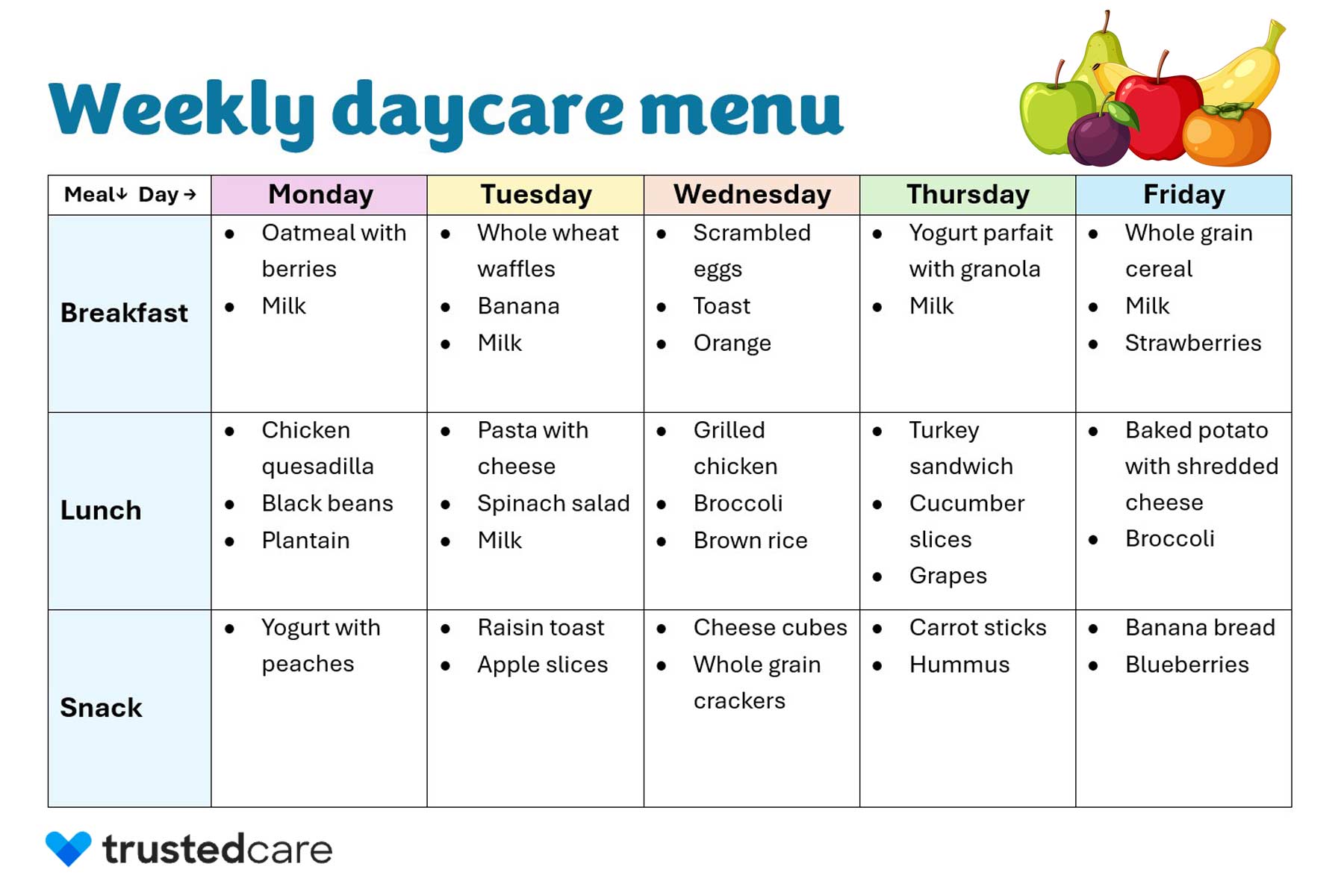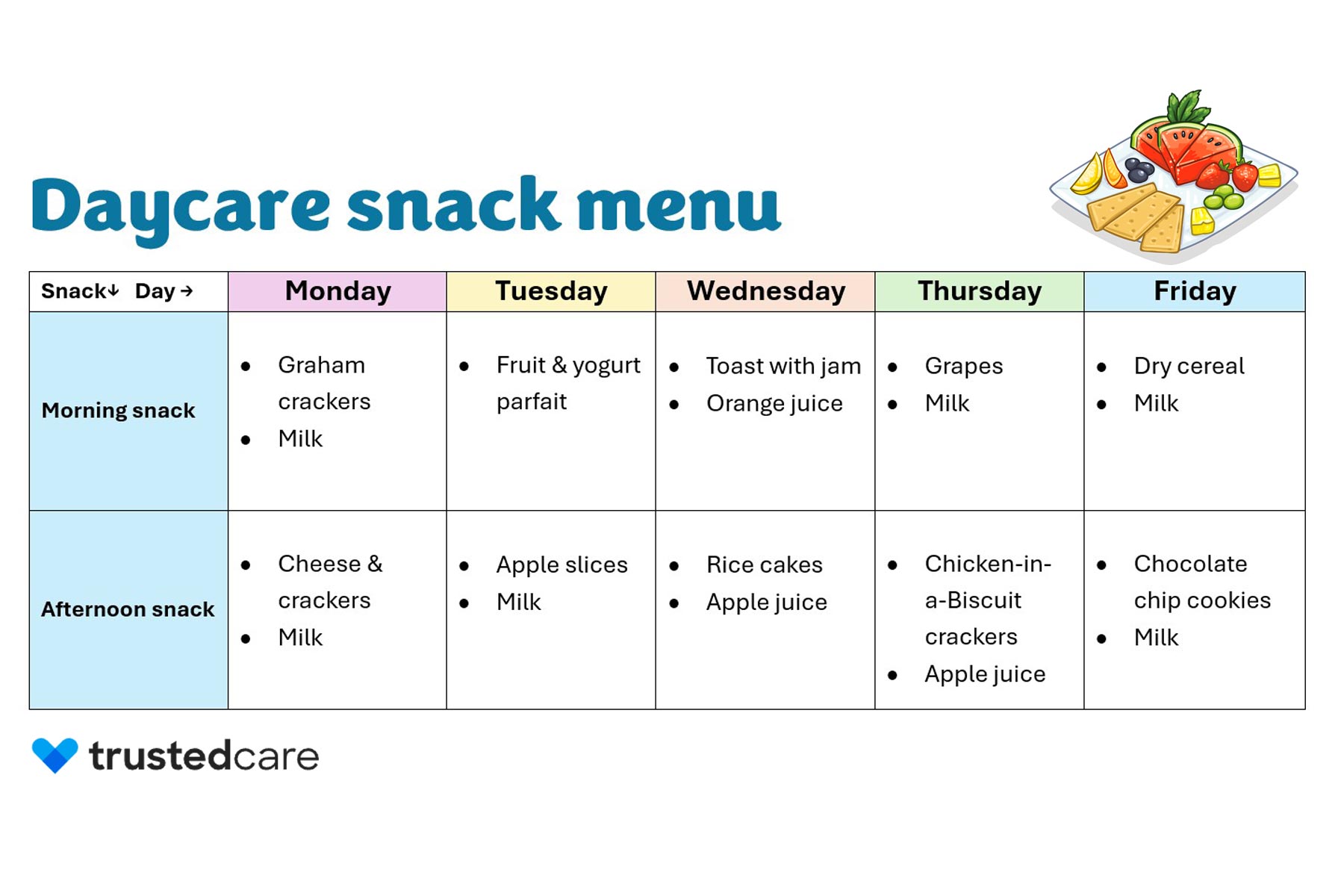
Daycare Menu Ideas and Sample Menus
Daycare Menu Ideas and Sample Menus
In this guide, we'll walk through everything you need to know about building a standout daycare menu. You'll find practical tips, sample menus, expert guidance on nutrition, and ways to make mealtimes fun and stress-free. Whether you're new to menu planning or looking to refresh your offerings, you'll find inspiration and actionable advice here.
Why a thoughtful daycare menu matters
A well-designed daycare menu is a cornerstone of quality child care. The foods you serve fuel children's bodies and minds, supporting their physical growth, cognitive development, and emotional well-being. Nutritious meals help kids stay energized, focused, and ready to learn and play.
But there's more to it than just nutrition. Mealtimes are a major social event in the daycare day. They're a chance for children to practice independence, develop fine motor skills, and learn about new foods in a relaxed, supportive environment. When you offer a variety of healthy, appealing foods, you're helping children develop positive attitudes toward eating and setting the stage for a lifetime of good habits.
Child care menu guidelines and regulations
Daycare providers must navigate both federal standards and state-specific requirements. The good news? The Child and Adult Care Food Program (CACFP) not only sets helpful nutrition guidelines but also provides reimbursements ranging from up to $2.37 for breakfast and up to $4.43 for lunch in most states.
CACFP requirements include:
Five meal components: milk, fruits, vegetables, grains, and meat or meat alternates
At least one whole grain-rich serving daily
Added sugar limits for cereals and yogurt (effective October 2025)
Juice limited to one serving daily for children over 12 months
No juice for infants under 12 months
State licensing requirements typically include:
Advance menu posting (usually one week)
Current staff training certifications
Regular health department inspections
Commercial kitchen equipment (varies by state and program size)
Practical tips for planning your daycare menu
Designing a daycare menu can feel overwhelming, but a little organization goes a long way. Create a structured daycare schedule that includes designated meal and snack times, then follow these tried-and-true tips to make menu planning easy and effective:
1. Start with a strong breakfast
A nutritious breakfast sets the tone for the entire day and provides children with the energy they need for learning and play. Aim for a combination of quality protein, whole grains, fruit, and dairy to keep children satisfied and energized. A good breakfast helps children stay full and focused all morning.
2. Mix familiar favorites with new foods
Kids thrive on routine, but they're also naturally curious. Include foods you know your group enjoys, but don't be afraid to introduce new items alongside familiar favorites. For example, serve a new vegetable with a well-loved main dish. This encourages children to try new things without pressure.
3. Plan ahead and shop smart
Menu planning is much easier when you do it weekly or monthly. Create a rotating menu cycle to save time and reduce stress. Keep a running shopping list organized by food group. This streamlines your grocery trips and ensures you always have what you need on hand.
4. Make meals visually appealing
Kids eat with their eyes first! Use colorful fruits and veggies, fun shapes, and creative presentations to make meals inviting. Try cutting sandwiches into shapes, arranging fruit in a rainbow, or serving "ants on a log" (celery sticks with nut butter and raisins).
5. Accommodate allergies and dietary needs
Today's daycare settings welcome children with diverse dietary needs, from food allergies to religious preferences. With careful planning, you can ensure every child feels included and well-fed. Always check for allergies and dietary restrictions. Offer alternatives as needed, and keep updated ingredient lists handy for parents.
Vegetarian and vegan options: Offer plant-based proteins like beans, lentils, tofu, and soy yogurt. Many classic dishes, like pasta with marinara, veggie stir-fry, or bean tacos, can easily be made vegetarian or vegan.
Gluten-free diets: Stock gluten-free bread, pasta, and crackers. Rice, potatoes, and corn are naturally gluten-free and can be used in many dishes.
Lactose intolerance: Offer lactose-free milk, fortified soy or oat milk, and dairy-free yogurts or cheeses.
Religious or cultural preferences: Some families may avoid pork, beef, or certain animal products for religious reasons. Communicate openly with parents and offer alternative menu choices as needed.
6. Involve children in meal prep
Even young children can help with simple tasks like washing veggies, stirring batter, or setting the table. Most kids love to help! Involving them in meal prep gives them a sense of ownership and makes them more likely to try new foods.
7. Keep portions child-sized
Offer small, manageable portions. This helps prevent food waste and allows kids to listen to their own hunger cues. Start with smaller servings of new foods to make them less intimidating, and remember that a child's stomach is about the size of their fist. You can always add more if they're still hungry.
8. Rotate your menu
A four-week rotating menu keeps things fresh and gives you a chance to introduce seasonal produce. It also makes planning and shopping more efficient. By cycling through different meals, you'll prevent menu fatigue while ensuring variety in nutrients and flavors. Keep a master list of successful meals to reference, and don't be afraid to repeat popular dishes more frequently.
9. Communicate with parents
Share your menu in advance. Post it on a bulletin board, send it via email, or use a parent communication app. This keeps parents in the loop and allows them to reinforce healthy eating at home. It also allows them another opportunity to communicate back to you if their child has any specific dietary needs or restrictions.
10. Stay flexible
Be prepared to adjust your menu based on what's in season, what's on sale, or what your group is loving right now. Flexibility is key to keeping everyone happy and well-fed. Have backup meal ideas for busy days, and consider keeping simple ingredients on hand for quick substitutions. Sometimes the best meals come from spontaneous changes to your original plan.
Sample daycare menus
To help you visualize how to put it all together, below is a sample weekly daycare menu that balances breakfast, lunch, and snacks. This sample includes a mix of familiar and new foods, covers all food groups, and follows USDA nutrition standards for child care meals.
| Day | Breakfast | Lunch | Snack |
|---|---|---|---|
| Monday | Oatmeal with berries, milk | Chicken quesadilla, black beans, plantain | Yogurt with peaches |
| Tuesday | Whole wheat waffles, banana, milk | Pasta with cheese, spinach salad, milk | Raisin toast, apple slices |
| Wednesday | Scrambled eggs, toast, orange | Grilled chicken, broccoli, brown rice | Cheese cubes, whole grain crackers |
| Thursday | Yogurt parfait with granola, milk | Turkey sandwich, cucumber slices, grapes | Carrot sticks, hummus |
| Friday | Whole grain cereal, strawberries | Baked potato with shredded cheese, broccoli | Banana bread, blueberries |

Daycare breakfast menu
Daycare breakfasts should include whole grains, protein, and dairy to start the day off right.
| Day | Breakfast |
|---|---|
| Monday | Oatmeal, diced apples, 1% milk |
| Tuesday | Whole wheat bagel, egg omelet, blueberries, 1% milk |
| Wednesday | Waffles, peaches, 1% milk |
| Thursday | Wheat Chex, raspberries, 1% milk |
| Friday | Scrambled eggs, sweet potato hash, 1% milk |
Daycare lunch menu
Daycare lunches should offer balanced portions from all food groups to support healthy growth and development.
| Day | Lunch |
|---|---|
| Monday | Build your own sandwich, cucumber slices, pears, 1% milk |
| Tuesday | Beef & noodles, corn, fruit cocktail, 1% milk |
| Wednesday | Chicken nuggets, French fries, peaches, dinner roll, 1% milk |
| Thursday | Cheese pizza, fruit cocktail, 1% milk |
| Friday | Ham steak, squash, pineapple, cornbread, 1% milk |
Daycare snack menu
Daycare snacks should combine two of the four main food groups: grains, fruits/vegetables, protein, and dairy.
| Day | Morning Snack | Afternoon Snack |
|---|---|---|
| Monday | Graham crackers and milk | Cheese and crackers, milk |
| Tuesday | Fruit and yogurt parfait | Apple slices and milk |
| Wednesday | Toast with jam and orange juice | Rice cakes and apple juice |
| Thursday | Grapes and milk | Chocolate chip cookies and milk |
| Friday | Dry cereal and milk | Chicken in a Biscuit crackers, apple juice |

Monthly daycare menu planning
Creating a monthly menu cycle reduces daily planning stress while ensuring variety and balanced nutrition. A well-designed monthly rotation keeps children interested while streamlining your shopping and preparation. Use the following tips to help you build a successful monthly menu for your daycare:
Note holidays and special events that might affect attendance.
Plan around seasonal produce availability.
Include backup options for supply disruptions.
Mark days for introducing new foods.
Schedule popular favorites regularly to maintain satisfaction.

FAQs about daycare menus
How often should I change my daycare menu?
Most daycare providers use a four-week rotating menu, updating it seasonally to include fresh produce and new recipes. This keeps things interesting for kids and makes planning easier for you.
What if children refuse to eat certain foods?
It's common for young children to be cautious about new foods. Offer new items alongside favorites and encourage (but never force) tasting. Sometimes it takes multiple exposures before a child accepts a new food.
How can I manage food allergies safely?
Food allergy management requires comprehensive planning and staff training. Create individual care plans for each allergic child including specific allergens to avoid, emergency treatment protocols, and epinephrine administration procedures if needed. Communicate clearly with parents about ingredients and substitutions.
Prevent cross-contamination through separate preparation areas, utensils, and storage. Triple-check ingredient labels and maintain separate serving utensils for each food item. Train staff to recognize anaphylaxis symptoms and proper emergency response procedures.